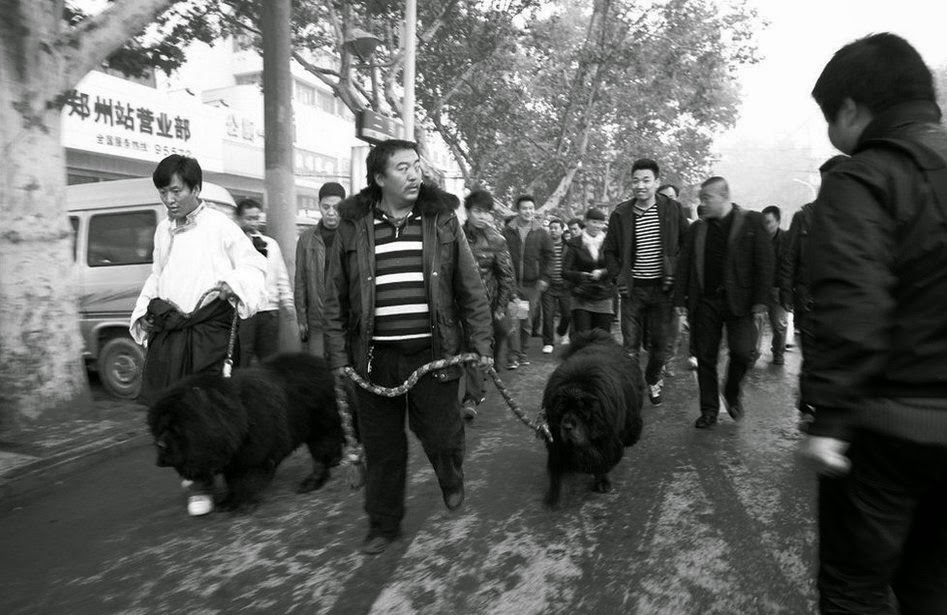
High Peaks Pure Earth has translated a blogpost by Woeser written in May 2015 for the Mandarin service of Radio Free Asia and published on her blog on May 6, 2015.
(Photo Caption: News from November 28, 2011 – A man named Niu, the owner of a Tibetan mastiff camp in southern Beijing, had found two pure mastiffs to have them mate and produce offspring for his camp; if successful, he would pay 50,000 Yuan; to welcome the two valuable mastiffs, he had arranged the guests, including the dogs from Yushu to be picked up in a BMW and organised beautiful girls to hold a welcoming ceremony.)
“Tibetan Mastiffs as A Metaphor”
By Woeser
When I read about the heated debate revolving around the article published by the New York Times on April 19, that rich Chinese no longer want Tibetan mastiffs as pets, but have been selling them for USD 5 to slaughterhouses to have them rendered into hot pot ingredients, imitation leather or the lining for winter gloves, I was not really shocked. I have always known that taking the symbol of the Tibetan plateau out of its original environment will end in this way. It is just that this most painful and humiliating end has come too quickly. Two years ago, I heard from a friend from Yushu that their relatives sold their mastiff to a dog trader from Henan for four million Yuan. The trader paid a first installment of two million and promised to pay the remainder once he sold the dog. I wonder whether this Yushu mastiff, after having had to wait for the highest bidder, has by now also been turned into slices of hot pot meat?
 Yushu is said to be the homeland of Tibetan mastiffs. But this is more likely to be a legend manufactured by the many traders who wanted to hype Yushu to make money. I remember five years ago, after the earthquake, even “rescue workers” wearing orange jackets shamelessly stole young mastiffs; this was photographed by volunteers. Even today, many people still do not believe this. But Ren Wentao who participated in the rescue team wrote on Twitter: “there is no doubt that people have been stealing mastiffs hoping to make some profit.” Some Tibetan volunteers also revealed: “there are some who use volunteering groups as a means to steal Tibetan mastiffs…”
Yushu is said to be the homeland of Tibetan mastiffs. But this is more likely to be a legend manufactured by the many traders who wanted to hype Yushu to make money. I remember five years ago, after the earthquake, even “rescue workers” wearing orange jackets shamelessly stole young mastiffs; this was photographed by volunteers. Even today, many people still do not believe this. But Ren Wentao who participated in the rescue team wrote on Twitter: “there is no doubt that people have been stealing mastiffs hoping to make some profit.” Some Tibetan volunteers also revealed: “there are some who use volunteering groups as a means to steal Tibetan mastiffs…”
And it is not only Yushu, many mastiff camps can be found in other areas across Tibet, including Lhasa; often these were set up by the military or police to raise, train and trade mastiffs on a large-scale. I once encountered such a camp. It was on the way from Lhasa to Gongkar Airport; the camp belonged to the fire brigade of the People’s Armed Police force; I heard that it was a breeding ground for corruption.

In 2011, film director Pema Tseden raised the sad issue of Tibetan mastiffs in his film “Old Dog”; it was a time when the animals were still “hot”. It tells the story of a son who sells his family’s mastiff for a small sum of money; his father who feels strongly about the animal opposes the loss of the dog, buys it back, but eventually sees no alternative but to kill the family pet. Professor Tsering Shakya of the Institute for Asian Studies at the University of British Columbia writes in a review: “The film deals with the encroachment and destabilizing effect on Tibetan – or perhaps any – culture [not of the Cultural Revolution but] of China’s economic transformation… ‘Old Dog’ is a Tibetan’s view of the Tibetan landscape today… ‘Old Dog’ is littered with motifs that speak volumes of intrusion: the fence that signifies both the economics of privatization and deprivation of the land and the people, the dealer who tries to persuade the old man to sell his dog by saying that the dog will have a better life in the city (the old man responds, ‘So what is it that the city folks are frightened of?’), and the treasured possession of the poor that is stolen because of greed and commercial opportunism.”
The fact that Tibetan mastiffs have been sold to various different places and turned into pets is a kind of metaphor. In a nutshell, mastiffs stand for the fate of the Tibetan people. With regards to this, I wrote in an article titled “An Owner and His Pet – Tibetan/Han Relations” revolving around the protests that erupted across the entire Tibetan region in March 2008:
“The Tibetan mastiff is the most famous animal living on the Qinghai-Tibetan Plateau. It seems so rare and so valuable that some Chinese tycoons or those who pose as lovers of culture spend vast amounts of money in a rivalry to purchase the mastiff which they also have to feed with lots of meat every day. But one day, the Tibetan mastiff all of a sudden gets angry and bites the person who has become its owner, and the animal is beaten to death on the spot. Chinese newspapers often relate this kind of story. And it perfectly illustrates the relationship between Tibetans and Chinese. This is actually the real and fundamental relations between ethnic groups in Chinese society. If Tibetans are content with being pets, the Han people will maintain the tender feelings they once had towards Tibetans; and just like they are willing to feed cats or dog they like, those Han people will keep on “loving” Tibet. But human beings are not pets: pets do not have a volition of ego, whereas human beings do. Tibetans do not want to be pets, for the consequence of being a pet involves the loss of self, and ultimately the loss of Tibet. Therefore, as long as Tibetans are not content with being pets, or not content with accepting their fate of being pets, and bravely fight for the their being human beings and being Tibetans, then this is what brings trouble. In fact, trouble is already there; Tibetans are sometimes arrested, detained, tortured or even massacred. These are punishments inflicted by the country’s regime. To the Han people who evolve in the non-government sphere, the fact that some Han people changed sides so quickly allowed the truth to surface. And the truth is that Tibetans cannot act as humans. As soon as they do, they are exposed to fatal risks.”
 But the metaphor extends beyond this. As a result of the current unbearable humiliation of the once so valuable mastiffs, many Tibetans, especially those that are well-educated and a little bit famous, have been disseminating an image online, showing the profile of a black mastiff standing on the vast green grasslands; the caption reads “take you back to the grasslands” in English and Chinese. In reality, it is quite a difficult task to bring all the mastiffs that have been sold to people all across China back to the grasslands. For many years, they have been crossbred, forced to mate, subject to silicon injections and plastic surgery; they have thus changed beyond recognition; their character has also transformed and so, if one brings them back to the grassland, will this not create even more chaos among mastiffs? I believe that the last paragraph of “The Death of the Tibetan Mastiff” by the poet Gade Tsering reflects the truth:
But the metaphor extends beyond this. As a result of the current unbearable humiliation of the once so valuable mastiffs, many Tibetans, especially those that are well-educated and a little bit famous, have been disseminating an image online, showing the profile of a black mastiff standing on the vast green grasslands; the caption reads “take you back to the grasslands” in English and Chinese. In reality, it is quite a difficult task to bring all the mastiffs that have been sold to people all across China back to the grasslands. For many years, they have been crossbred, forced to mate, subject to silicon injections and plastic surgery; they have thus changed beyond recognition; their character has also transformed and so, if one brings them back to the grassland, will this not create even more chaos among mastiffs? I believe that the last paragraph of “The Death of the Tibetan Mastiff” by the poet Gade Tsering reflects the truth:
“I wanted to find something enrapturing in this story, perhaps the deep and moving relationship between Tibetans and mastiffs. In the end, I did no longer want to delve into the betrayal of this profound compassion; or enlarge on the actual reality, a reality driven by various social intentions. This is an unimaginable conclusion that I draw from what has actually happened on my very own home soil – the Tibetan plateau. Today, people long for the Tibetan mastiff, but it is clear: they will still follow the old path: selling everything they possess, until they are left with nothing!”
May 2015





Follow Us!